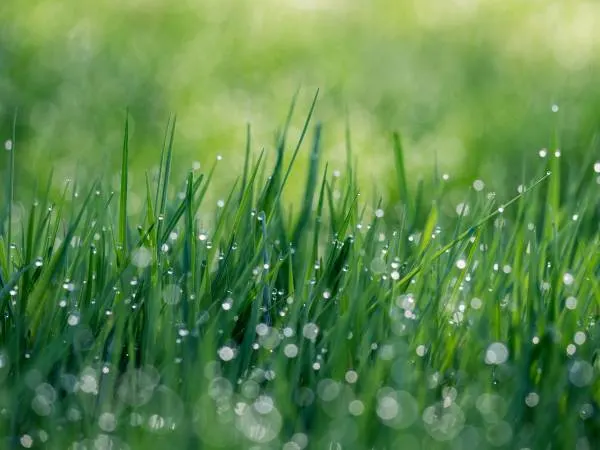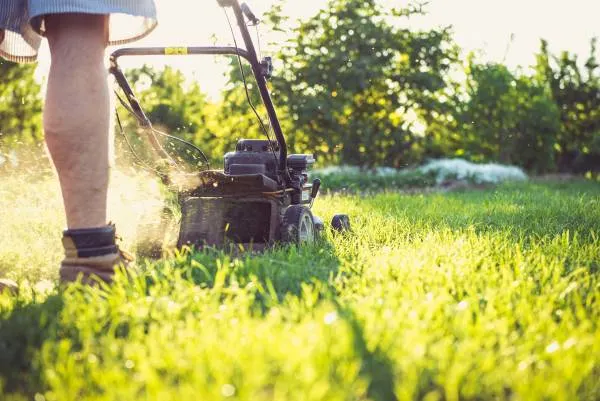Every homeowner dreams of having a lush, green lawn, right?
Well! There is this cool thing called hydroseeding that lots of people are using to get that perfect grassy look.
Ever heard of it?
Hydroseeding is a technology that is becoming popular for rapidly establishing grass and turf on steeper slopes and places where traditional sod planting is not possible.
But, like everything good, there is a catch.
Hydroseeding needs a bunch of water after you have planted it. But how long can hydroseed go without watering? That is what you are looking for, right?
Today, in this article, we will discuss the complete details regarding hydroseeding.
So, without wasting any further time, let’s begin!

What Is Hydroseeding?
Hydroseeding, or hydraulic mulch, is a fantastic method for establishing vibrant lawns and preventing soil erosion.
This innovative method involves a water-based mixture of grass seeds, fertilizer, a protective mulch blend, and a solidifying agent (cellulose fiber or wood mulch) – forming a green slurry.
The distinctive green slurry acts as a sponge for your soil, effectively retaining moisture, expediting grass seed for sprouting, and ensuring robust lawn growth. It’s a modified solution for different soil types, as experts analyze soil samples, adjust the mixture accordingly, and create optimal conditions for successful lawn development.
This process is strategically employed on areas with plain patches or plowed, ensuring the topsoil is coated. The goal is to provide a uniform supply of nutrients and moisture, promoting and accelerating germination.
If you’re seeking an uncomplicated yet effective way to cultivate a thriving lawn, hydroseeding stands out as a straightforward and beneficial approach.
How Long Can a Hydroseeded Lawn Go Without Water?
Hydroseeding works wonders for your lawn, growing faster and costing less than other methods.
You will see the results quickly and with minimal dust pollution and weed growth, even when it is done in a larger area.
But here’s the thing—it’s thirsty!
Hydroseed must always stay moist to ensure root growth and proper germination, which takes about 7-10 days, or in adverse conditions, about 14-15 days.
The water requirements depend on how long it has been since you have hydro-seeded your lawn.
Newly hydro-seeded lawns are thirsty and need to stay wet all the time for a minimum of 11 consecutive days.
To meet this need, you are imperative to reduce the thirst of your hydro-seeded lawn with multiple watering sessions each day, ensuring water flows for about 15-20 minutes throughout each watering cycle.
After 4-5 weeks, you can begin to scale back on the irrigation system water requirements gradually.
ProTip: The best times to water are early morning, noon, and late afternoon. Try not to water in the dark, as it creates water pools on the lawns, leading to overwatering, which is as bad as underwatering.
If you specifically want to know how long it can survive without water, keep in mind that a hydro-seeded lawn cannot last over a day or two without watering.
The reason is that seeds require water for germination and need to be watered before and after the germination process.
Forget to water, and it’s like hitting pause on your lawn’s growth.
So, keep the soil damp, not too soggy, and watch your lawn wake up. It’s a bit of effort that really pays off for a mature lawn, that stands out in the neighborhood.
How Do You Prepare Your Lawn for Hydroseeding?
Before you start hydroseeding, it’s crucial to get the ground ready.
First off, make sure the soil is aerated and moistened so the seeds can contact well with it. This is super important, especially if your soil is tough.
Adequate coverage is essential to enable the new roots to reach and extend into the soil.
It’s also a good idea to clear out any weeds and plants from the area you’re hydroseeding.
Make sure to spray the seed mixture evenly to cover everything. If there are rocks or old tree stumps, removing them will help your grass grow better.
Some people use a weed killer two weeks before hydroseeding. This helps get rid of any unwanted plants.
Sometimes hydroseeding doesn’t work because the preparation isn’t right.
On construction sites, the soil can be too hard. Adding a little topsoil might help, but it’s not a long-term fix.
For a strong and healthy lawn, you need to make your soil better. Mixing in stuff like peat moss or compost can help a lot.
If your soil is super hard or has lots of rocks, adding at least 4 inches of soil on top can give the roots more room to grow deep.
This way, your lawn can handle floods and dry spells better.
How to Maintain Your Hydro-Seeded Lawn?
Maintaining a hydro-seeded lawn involves a mix of care and attention to ensure it flourishes into a lush green space.
Let’s break down the essential aspects of maintenance in simple terms:
Watering
Water your newly hydro-seeded lawn multiple times a day for the first few weeks. That helps the seeds wake up and establish strong roots.
As your grass gets more established, you can water every two or three days. Be sure to adapt your watering schedule to the weather — as hotter days may require more frequent watering.
After germination, excess water causes grass seedlings to develop weak roots due to low oxygen supply, leading to a slow establishment process.
Aim for maintaining frequently enough moisture while avoiding overwatering to create the perfect growing environment.
It is because of rain, too little amount of water slows down the formation of grass. Contrarily, too much water causes washouts and puddles.

Mowing
Don’t rush to mow new lawn right after hydroseeding.
Wait until your grass is about 3 to 4 inches tall. Set your mower blade to a higher setting, around 2 to 2.5 inches.
It helps protect the developing roots and encourages a healthier lawn. Maintaining an optimal mowing height is crucial.
Ideally, the grass should be mowed at a precise height in between 1.5 to 2 inches.
Mowing isn’t just about a mow and giving your lawn a neat appearance; it’s a science that fosters the growth of tillers.
More tillers mean your lawn will fill in faster, giving it that lush look you crave.
ProTip: If you’re dealing with a newly seeded lawn, ensure that the mover blades are sharp enough to achieve clean cuts and set your mower speed slow to minimize the chances of pulling seedlings.

Fertilizing
Your newly hydroseeded lawn needs nutrients to thrive.
Consider a balanced fertilizer after the lawn begins first mowing, around 4 to 6 weeks after hydroseeding.
It’s like giving your lawn an extra boost to keep it healthy.
Read and follow the fertilizer instructions carefully. It is because too much fertilizer can be as harmful as too little.
Traffic
In the early days, treat your newly hydroseeded front lawn like a delicate flower.
Minimize foot traffic to allow the new grass itself to establish itself. Hold off on heavy activities, like setting up furniture or playing sports, until your grass is well-established.
Patience pays off, and your lawn will thank you for it.
Weed Control
Weeds can be sneaky, so keep a close watch.
Hydroseed do not have weeds, but they are present in the soil and can grow into your established lawn already.
Remember! Do not use any type of herbicide to kill weeds in the first three months.
But if you want to control the weeds after three months, it is better to use a herbicide spray. This is because spray covers better parts of the weeds than dry granular products.
Follow product instructions for safe and effective use.
Why Is My Hydroseed Not Growing?
You’ve put in the effort to weed seeds, but your hydroseed isn’t cooperating. Let’s troubleshoot why it might not be growing:
Hydroseed needs water — a lot of it, especially in the early days. If you’ve been stingy with the watering can, your seeds might be struggling to sprout.
Maybe you planted during the wrong season or faced extreme weather conditions. Just like trying to grow a sunflower in the dead of winter — it’s just not the right time.
When personally applying the hydroseed cover, you’ll be responsible for blending the seeds into the hydro-mulch mixture. If there are insufficient seeds, they may not give the full coverage, causing sparse and uneven growth.
If the soil is too hard, the roots can’t penetrate it easily. Consider aerating the soil to loosen it up.
Your soil might be lacking essential nutrients. Fertilizers are needed to give your grass the food it craves.
Weeds can be bullies, stealing water and nutrients from your grass. Keep an eye out and deal with them promptly.
Sometimes, it’s just a matter of waiting. Grass takes its time to grow, and impatience can be the enemy.
By addressing these issues, you’ll likely find out the reason behind your hydroseed’s reluctance to grow.
With a bit of care and patience, you’ll be on your way to a flourishing, green lawn.
That’s all for today!
Now, it’s time to move toward the conclusion.
Conclusion!
Hydroseeding emerges as a transformative solution for homeowners seeking lush, vibrant lawns with minimal effort.
This innovative method, utilizing a water-based blend of grass seeds, fertilizer, mulch, and a solidifying agent, proves particularly effective in challenging terrains and large areas where traditional sod planting may falter.
However, maintenance involves a delicate balance of watering, mowing, fertilizing, and vigilant weed control.
While hydroseeding promises rapid results, patience is essential, and addressing potential issues such as insufficient watering, poor soil conditions, or weed interference is crucial.
With care and perseverance, hydroseeding offers the promise of a flourishing, green lawn that stands out in any neighborhood, transforming the homeowner’s dream into a reality.
I hope this post helps you a lot. If you have any other question regarding hydroseeding, don’t hesitate to ask it in the comment section below.
Regards,
Moiz Atiq.
